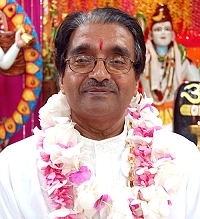From a satsang with Paramacharya of SWAHA, H.H. Pundit Hardeo Persad
Sanaatan Dharma, deeply philosophical and imbued with eternal wisdom, presents its teachings through multiple layers of mythology, rituals and universal truths. The ultimate goal of worship in Hinduism is to realise the innate connection with the Universal Divine. While many devotees worship with love and devotion—an admirable expression of faith—the principles of gyaan bhakti must also be of significance. It emphasises that we must not only participate in rituals and prayers but also seek a deep understanding of their significance. Knowledge enhances devotion, guiding the seeker towards a full spiritual experience.
In Hinduism, there are three distinct paths to unlocking the mysteries of existence: the mythological, which expresses truths through symbolic stories; the cosmological, which reflects the universal laws governing life; and the metaphysical, which connects the vastness of creation with the individual soul. As the Vedas declare, “As is the microcosm, so is the macrocosm.” A profound teaching, it reminds us that the Divine principles that pervade the universe also dwell within each of us.
The depth of symbolism in Hinduism serves as a bridge between the external forms of the Divine and the internal qualities they represent. Among the most revered forms of the Divine is Devi. Hinduism stands unique in its celebration of the Divine Mother in all her manifestations. Devi’s primary forms — Durga Maa, Lakshmi Maa, Saraswati Maa and Kaali Maa — each represent a vital force of the universe. Durga Devi embodies Icchhaa Shakti, the power of will; Lakshmi Devi is representative of Gyaan Shakti, the power of wisdom; Saraswati Devi represents Kriyaa Shakti, the power of enlightened action; and Kaali Devi signifies the power of time.
In addition to these forms, Devi manifests as the Das Mahaa Vidyas —the ten embodiments of transcendental wisdom. Kaali Devi is the first, symbolising the power of time; Taara Devi, the power of hunger; Shodasi Devi, the power of perfection; Bhuvaneshwari Devi, the power of knowledge; Chinnamasta Devi, the power of self sacrifice; Bhairavi Devi, the power of death; Dhoomavati Devi, the power of poverty; Bhagalamukhi Devi, the power of cruelty; Maatangi Devi, the power of domination; and Kamala Devi, the power of wealth. Yet, despite these many forms, there is only one Shakti, one Divine Energy that flows through all.
Devi, as the primordial energy, manifests in many forms, each personifying an aspect of universal energy: light, sound, heat and so forth. Just as the universe is composed of these energies, so too are we. Every aspect of Devi, from Durga Devi’s strength to Saraswati Devi’s enlightened action, resides within us. To worship Durga Devi is to invoke the internal willpower, enabling us to overcome all obstacles and negativity. Every act of worship, every self sacrifice, is a means to reconnect with the dormant Divine powers within us. Thus, the spiritual path leads inward, to the discovery that the Lord is present within, always guiding and protecting us.
The Devi Kavach, a powerful invocation of the Devi, calls upon her various forms to protect associated parts of the body. These forms correspond to the energy centres, or chakras, within the human body. As ancient sages realised, all matter is energy, vibrating at different frequencies. Einstein’s theory of relativity echoes this eternal truth: E=MC². Through the worship of Devi, we access and harmonise these energies within us. The body contains seven primary chakras, each governing specific organs and systems. To maintain health and vitality, it is essential to energise and balance these chakras, particularly when they become weak or blocked. Worshipping Devi is a sacred method of reawakening the energies within, allowing us to live in harmony with both our inner and outer worlds.



